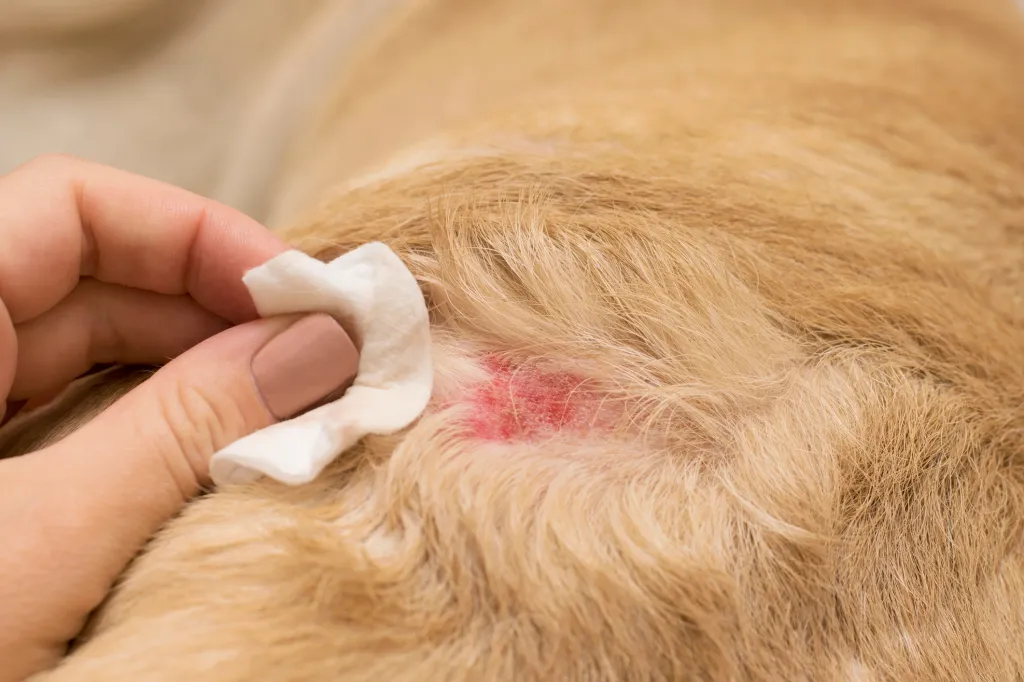Table of Contents
What is folliculitis?
The word folliculitis means “inflammation of the hair follicles.”
Most dogs and cats have millions of hair follicles across their body. These hair follicles are found within the skin, and they occur anywhere that you see hair growing on your pet. Each hair follicle serves as the source of multiple hairs, responsible for creating the thick coat that we typically associate with our canine and feline companions.
Folliculitis refers to inflammation of these hair follicles. There are many potential causes of folliculitis, and folliculitis can take on a variety of clinical appearances.
What causes folliculitis?
Most cases of folliculitis are associated with a bacterial infection. Like humans, dogs and cats normally have bacteria, including Staphylococci (“staph”), on the surface of their skin. In a healthy dog or cat, the skin’s barrier function serves to keep these bacteria in check, preventing them from entering the skin’s structures, proliferating unchecked, and causing an infection. In some cases, however, these bacteria can invade the hair follicle and create an infection of the follicle. This infection leads to folliculitis.
Bacterial folliculitis can occur in any pet, when the conditions are right. However, it is often associated with underlying allergies. Skin allergies disrupt the skin’s barrier function, making the pet more susceptible to bacterial skin infections.
Not all cases of folliculitis are caused by skin infections or allergies. Other possible causes of folliculitis include:
- Fungal infection (e.g., ringworm)
- Parasites (e.g., demodex mites)
- Skin irritation/trauma (e.g., clipper trauma due to grooming, lick granuloma)
- Hypothyroidism
- Cushing’s disease
Diagnostic testing is typically required to determine the cause of folliculitis.

What are the symptoms of folliculitis in dogs and cats?
The most common symptoms of folliculitis are itching, redness of the skin, hair loss, and swelling. Unfortunately, these signs are common to a wide variety of skin conditions. Therefore, folliculitis can be difficult to differentiate from other skin diseases.
On closer examination, folliculitis may also show the following characteristics:
- Hyperpigmentation (darkening of the skin)
- Pustules (pus-filled bumps)
- Papules (bumps without pus)
- Epidermal collarettes (circular areas of hair loss and peeling skin)
- Abrasions and erosions (damage to the surface of the skin)
Does folliculitis require veterinary care?
Obtaining an accurate diagnosis of folliculitis, and identifying its underlying cause, requires a veterinary exam. Your veterinarian will begin by performing a thorough physical exam of your pet. This exam will include an emphasis on the skin, looking carefully at the skin in affected and unaffected areas. Your veterinarian will also examine the rest of your pet’s body, looking for evidence of systemic disease that may make your pet more susceptible to folliculitis.
Next, your veterinarian will likely recommend diagnostic tests. These tests are used to definitively diagnose folliculitis as the cause of your pet’s skin condition. Additionally, diagnostic tests can aid in determining the underlying cause of your pet’s folliculitis.
Recommended tests may include:
- Skin cytology, to examine skin cells under a microscope
- Skin scraping, to test for skin mites
- Fungal culture, to diagnose ringworm infection
- Skin culture and sensitivity, to diagnose bacterial infection and determine the best treatment
- Skin biopsy, to look for underlying skin disease
- Blood tests, to look for hormonal diseases like hypothyroidism and Cushing’s disease
- Allergy testing, to determine the underlying cause of allergic skin disease
- Food trial, to diagnose food allergies
Your veterinarian will make testing recommendations based on their physical exam findings. Exam findings can help suggest likely causes of a pet’s folliculitis, allowing the veterinarian to choose the most appropriate diagnostic tests for the patient.
How is folliculitis treated?
Folliculitis treatment will depend on the underlying cause of your pet’s condition.
As stated earlier, most folliculitis is caused by a bacterial infection. If your dog or cat’s folliculitis is caused by a bacterial infection, your veterinarian will likely prescribe an oral antibiotic. This may be accompanied by a topical antibacterial shampoo, spray, or ointment. Your veterinarian may also prescribe medication to alleviate your pet’s itching and inflammation.
Pets with underlying skin allergies may also need treatment to address their allergies. In the case of a pet with flea allergies, for example, your veterinarian may recommend effective monthly parasite prevention. Food allergies are often treated with a prescription diet, which can reduce skin inflammation and associated folliculitis flare-ups. Finally, some pets are allergic to inhaled allergens in their environment. Treatment of inhalant allergies may involve the use of medications (oral or injectable) or hyposensitization treatment (using allergy injections or sublingual allergen dosing). Your veterinarian will work with you to determine the best treatment for your pet’s allergies.
If your pet’s folliculitis is caused by mites, fungal infection, hormonal disease, or other cause, your veterinarian will work with you to determine the most effective treatment option for the underlying cause of your pet’s condition.
Your pet’s prognosis will depend on the underlying cause of their folliculitis. In some cases, folliculitis is an isolated, one-time occurrence that is easily addressed with treatment. In other cases, ongoing treatment may be needed and your pet’s response to treatment may vary.
Can I prevent folliculitis in my pet?
There is no guaranteed way to prevent folliculitis in pets. However, there are a few steps you can take to reduce the risk:
- Treat skin allergies proactively. Unmanaged allergies are a leading contributor to folliculitis. Work with your veterinarian or a veterinary dermatologist to develop an allergy management plan for your pet, keeping in mind that allergy management is a long-term process.
- Use a veterinary-recommended parasite preventive, to prevent fleas and other parasites that may cause folliculitis.
- Do your research when selecting a groomer. Clipper-associated trauma and poor sanitation can contribute to skin infections and folliculitis.
- Keep hormonal disease, like hypothyroidism and Cushing’s disease, well-controlled. Folliculitis can occur when hormonal diseases are poorly regulated.
- Seek veterinary care if you notice any signs of skin disease, such as itching or hair loss. Diagnosing and treating skin disease early can reduce the likelihood of progression to folliculitis.
If you have any concerns about your pet’s skin, contact your veterinarian.







